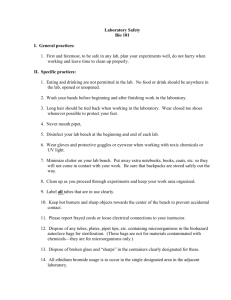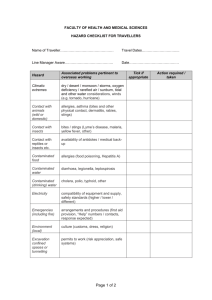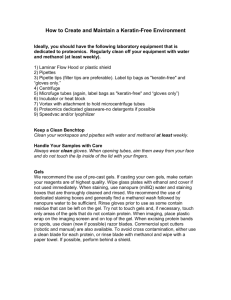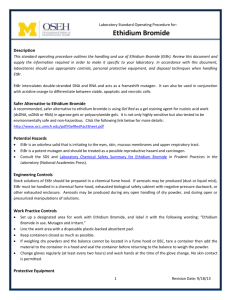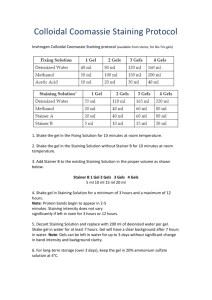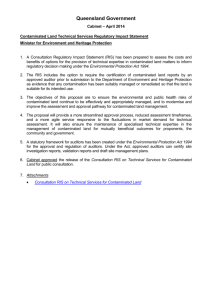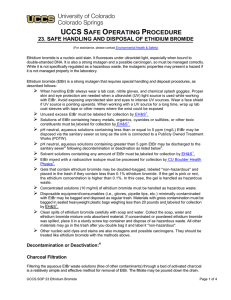Topic I: HANDLING MICROORGANISMS
advertisement
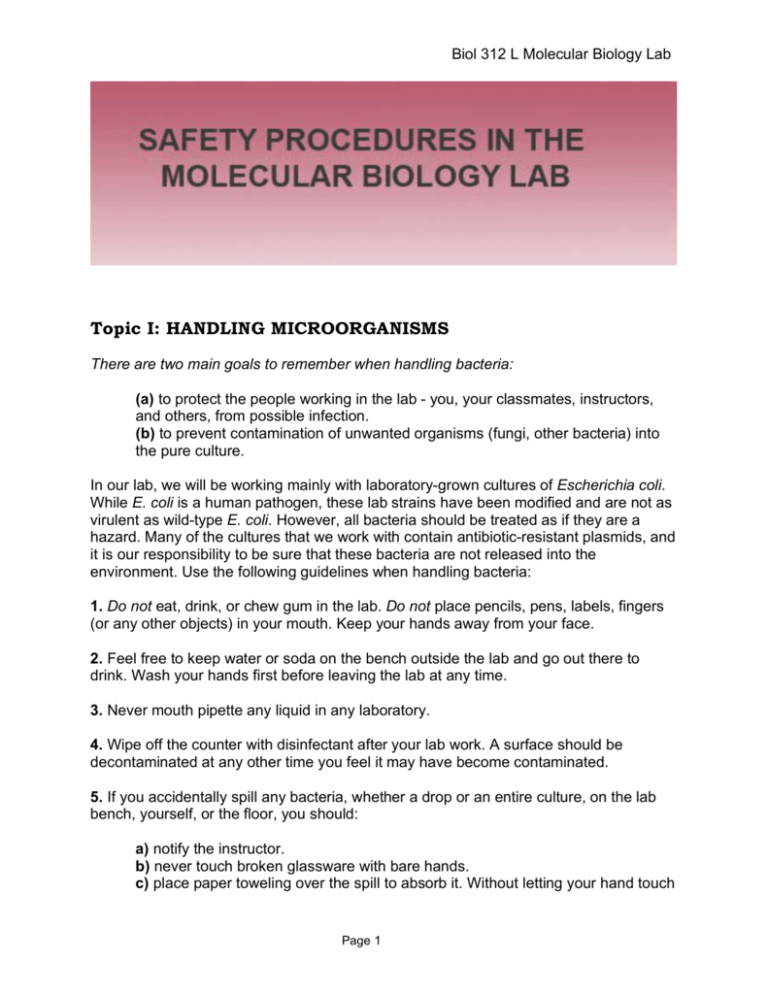
Biol 312 L Molecular Biology Lab Topic I: HANDLING MICROORGANISMS There are two main goals to remember when handling bacteria: (a) to protect the people working in the lab - you, your classmates, instructors, and others, from possible infection. (b) to prevent contamination of unwanted organisms (fungi, other bacteria) into the pure culture. In our lab, we will be working mainly with laboratory-grown cultures of Escherichia coli. While E. coli is a human pathogen, these lab strains have been modified and are not as virulent as wild-type E. coli. However, all bacteria should be treated as if they are a hazard. Many of the cultures that we work with contain antibiotic-resistant plasmids, and it is our responsibility to be sure that these bacteria are not released into the environment. Use the following guidelines when handling bacteria: 1. Do not eat, drink, or chew gum in the lab. Do not place pencils, pens, labels, fingers (or any other objects) in your mouth. Keep your hands away from your face. 2. Feel free to keep water or soda on the bench outside the lab and go out there to drink. Wash your hands first before leaving the lab at any time. 3. Never mouth pipette any liquid in any laboratory. 4. Wipe off the counter with disinfectant after your lab work. A surface should be decontaminated at any other time you feel it may have become contaminated. 5. If you accidentally spill any bacteria, whether a drop or an entire culture, on the lab bench, yourself, or the floor, you should: a) notify the instructor. b) never touch broken glassware with bare hands. c) place paper toweling over the spill to absorb it. Without letting your hand touch Page 1 Biol 312 L Molecular Biology Lab the absorbed liquid, place the paper towel into the "biological waste" container. d) disinfect the area thoroughly. e) wash your hands thoroughly with disinfectant and soap. Be careful not to touch anything else, including water faucets, with your contaminated hands. f) Do not spread contamination. For example, a tube that has culture spilt on the outside of the tube should not be placed back in a rack where it could contaminate the rack and the hands of the next person to touch it. 6. Label all plates, culture tubes, etc. before inoculating in order to lessen chances of error or spilling. 7. NEVER grab a culture tube by the cap. Many of the caps fit loosely on the tube. You won't know until the tube crashes to the floor. 8. Keep cuts or open wounds covered. Gloves are available. Report any injuries (no matter how minor), or allergy to latex gloves, to the instructor. 9. Come to lab properly dressed. Bare feet, flip-flops, or sandals are NOT ALLOWED. You can bring a pair of old tennis shoes and keep them in the lab for the semester. Open-toed shoes, unstable high heals, and shorts are discouraged. Do not wear your best clothes to lab. Feel free to wear a lab coat if you have one. 10. Wearing contact lenses to lab can pose certain hazards. Contact lens wearers should consult their ophthalmologist or optometrist for advice. Be aware that trace amounts of stains on the fingers can be transferred to soft lenses and that these lenses absorb chemicals, including vapors. Be careful to follow proper sterilization procedures. 11. Students at high risk for infection (e.g. uncontrolled diabetes, suppressed immune system, chemotherapy, steroid treatment) or those for whom an infection could be especially devastating (e.g. impaired kidneys, lacking a spleen) should (a) have the permission of their physician and (b) preferably notify the instructor. 12. After lab, students should properly dispose of all cultures, glassware, plastic ware, pipettes, and other supplies that have been in contact with bacteria. Containers marked "solid waste" and "liquid waste" are located on each bench. A "biological waste" wastebasket is available for petri plates and other contaminated solids. A separate waste container is provided for "sharps". This waste is autoclaved and so it is suitable for contaminated tips, plastic pipettes, etc. Glass pipettes are put into the cardboard "broken glass" container. If a pipette is contaminated with bacteria, it must be decontaminated first (soak in bleach). 13. All liquid cultures must be killed before disposal. Place cultures on a rack by the sink and add bleach solution or Wescodyne disinfectant to the tubes. Please remove tape from the tubes. Page 2 Biol 312 L Molecular Biology Lab Topic II: USE OF LABORATORY EQUIPMENT Much of the equipment that we use routinely in the lab is very expensive, and some of it is potentially hazardous if misused. You must take proper care of the equipment! Always ask if you aren't sure how to use. 1. Microfuges (Figure 1.1, left) must be properly balanced. Balance tubes are available near the microfuges. All students should carefully balance their own tubes. Our lab rule is: the person who closes the lid and starts the rotor is responsible for double-checking and insuring that the microfuge is balanced. 2. Micropipettors are critical to our work. Treat them with care. Use the right pipettor for the job. Do not overwind or underwind. Aren't sure of a setting? Just ask! 3. Electrophoresis boxes and power sources have the potential for electric shock if used improperly (Figure 1.1, right). Never turn on the power until the apparatus is completely connected. Wipe off any stray liquid from the lid, electrodes, or your hands before connecting the electrophoresis box to the power supply. 4. When using the shaking incubator, it is especially important to be sure that no bacterial culture is splashed into the incubator. Flasks should be securely fastened. Cap tubes well. Turn up rotor speed slowly. Figure 1.1: MIcrofuges and electrophoresis equipment are used frequently in lab. Microfuges must be balanced and lid tightened (if available). (photo by S. Dellis) Page 3 Electrophoresis boxes must be closed before current is applied. (photo by S. Dellis) Biol 312 L Molecular Biology Lab Topic III: GENERAL GUIDELINES 1. Keep you work area organized to reduce confusion, chance of error, or chance of spilling. Put away unneeded notebooks and papers. 2. Spills of reagents should be cleaned using paper towels followed by a thorough rinsing with water. For large spills or spills with potentially hazardous liquids (e.g. NaOH) notify the instructor. 3. Work on the lab bench, not on your notebook, over the floor, or in your lap. Topic IV: FIRST AID 1. Report all accidents immediately to the instructor. 2. For spills near or in the eyes, IMMEDIATELY proceed to the eyewash by the sink and flush eye with copious amounts of water. 3. For large spills on your person, use the sink. 4. For heat burns, the affected part should be chilled with ice as soon as possible and kept chilled. Topic V: FIRE Your response to a fire will differ depending on how large the fire is, the substance that is burning, and immediate danger to people. Not all situations can be listed here. Several times during the semester, we will be using alcohol to disinfect bacterial spreaders and burn off the excess with a candle flame. Obviously, this is a situation that you must carefully monitor. 1. If you have a small fire, the best way to put it out is to smother it (for example, with a book or lab coat but not your hand). Act quickly. In some cases, such as wood or paper, using water may be appropriate. Smother an alcohol fire. 2. If someone has a smoldering sleeve, run water on the fabric or smother the fire. 3. If a person is on fire, they should roll on the ground to smother the fire. Provide help with lab coats or towels to smother fire and water to extinguish. 4. If you have a large fire in the lab itself, or a fire alarm, then the room and building should be evacuated. If there is time, unplug electrical equipment. Leave the room, proceed down the nearest stairs, and immediately exit the building. Assemble outside the entrance to the Stern Center so that the instructor can take roll and make sure everybody has evacuated. Page 4 Biol 312 L Molecular Biology Lab Topic VI: NATURAL AND OTHER DISASTERS Natural disasters include earthquakes and hurricanes. If an earthquake tremor is felt, first make sure there are no open flames and then get under the lab bench. If Charleston is threatened by a hurricane, listen to the local news to find out if classes have been cancelled. If you are instructed to evacuate, do so! Every effort will be made to reschedule the missed lab periods. If any person, at any time, seems suspicious or threatening, leave the lab immediately! Once you are a safe distance away, call 911. Once again, if it is necessary to immediately exit the building, we will assemble in the entryway to the Stern Center so that the instructor can take roll and make sure everybody has evacuated. Topic VII: STAINING AND PHOTOGRAPHING GELS The process of staining and photographing gels contains two areas of potential hazard; staining with Ethidium Bromide and use of the ultraviolet light transilluminator. There are two main safety goals to remember: (a) Ethidium Bromide (EtBr) is used visualize nucleic acid. It is a flat (planar) molecule that gets in between (intercalates) the DNA base pairs of the double helix. However, EtBr can just as easily intercalate into your DNA. It is a mutagen and a possible carcinogen so you must protect yourself from contact with EtBr. Thus it is important that we use it properly. • The major problem with EtBr use is contamination of work surfaces with liquid from gels, contaminated paper towels, and gloves. You must always be aware of what you have touched with contaminated gloves so these surfaces can be wiped down. • To complicate matters, our gel staining/viewing area is located in the same room as other common-use equipment, so we must be especially careful that our EtBR use is contained and controlled. (b) UV light is used to see the DNA after staining. This is the first time we can actually see the DNA. This UV is similar to the UV of the sun that can burn the cornea of your eye or burn your skin, except this is a very strong dose of UV. Protecting yourself from ultraviolet light is simply a matter of preventing exposure. • You must ALWAYS wear safety goggles with UV protection when the UV light is on. NEVER look directly at the ultraviolet light without eye protection because it can damage the cornea of your eye. • With sufficient exposure, the UV can also burn the skin. If you have to spend time working on a gel over the light box, wear protective clothing like a long-sleeved shirt or lab coat. Be especially CAREFUL that your wrists and neck are not exposed to the UV because this sensitive skin can burn easily. Page 5 Biol 312 L Molecular Biology Lab Below are guidelines for EtBr use: 1. All surfaces on the large table used for gel staining/photography are considered to be contaminated: • the EtBr soak and EtBr rinse containers • the bench paper on the shaker and the plastic cover on the controls • the paper towel-covered tabletop and everything on it (spatulas, etc.) • the UV light box used to cut bands and the UV light box used for photographing gels • the focus and telephoto lens rings on the camera • the portable lamp near the gel staining area 2. The following surfaces must remain uncontaminated, and thoroughly cleaned if you suspect contamination: • the entire computer table that holds the computer equipment and printer. Do not take any chances that others are as careful as you are. Use a paper towel as a shield between your hand and the keyboard or mouse, or put on a clean glove if you will spend a lot of time at the computer. • the benchtop and drawers next to the computer table • the surrounding walls, doors, and door handles 3. These are surfaces that often become contaminated and need to be wiped: the main light switch in the UV room - be especially careful not to contaminate! • doorknobs, door frames, and doors • the handles on the water faucet • the outside surfaces of the EtBR wastebasket 4. When you first enter the gel room, turn on the portable lamp by the camera and turn off the main room light. Do this before your gloves are contaminated with EtBR. That way, the main light switch will not become contaminated. It is expected that the portable light by the gel staining bench will become contaminated. 5. Wear gloves when manipulating the gels, such as transferring from soak to rinse container, and moving them around on the light box. 6. When you are ready to take a picture, REMOVE your right glove. Use your ungloved right hand to touch all uncontaminated surfaces such as the keyboard and mouse. You can focus the camera or move the gel with your gloved left hand. Remember, gloved hand on contaminated surfaces ONLY. 7. When you have your final picture or file, then clean up the area. Dispose of unwanted gels in the small plastic tubs (extras are located under the table). Wipe off the light box and any stray contaminated liquid with paper towels. You can put on another glove if you need to. Throw paper towels into the EtBR wastebasket, take off your gloves, and throw them away also. 8. Using paper towels with soap and water, wipe any surfaces you think you may have contaminated. Page 6 Biol 312 L Molecular Biology Lab 9. Always wipe down the handles on the water faucet and the light switch in the UV room. Give the room a final inspection. 10. Then thoroughly wash your hands, get your printout or USB drive, and make sure the door is locked when you leave. 11. CUTTING BANDS: One additional note on this matter; the UV-transparent glass can be easily scored with a knife or razor blade. Do not cut directly on this glass! Put down a piece of saran wrap and cut on the saran wrap instead of directly on the glass. Page 7
